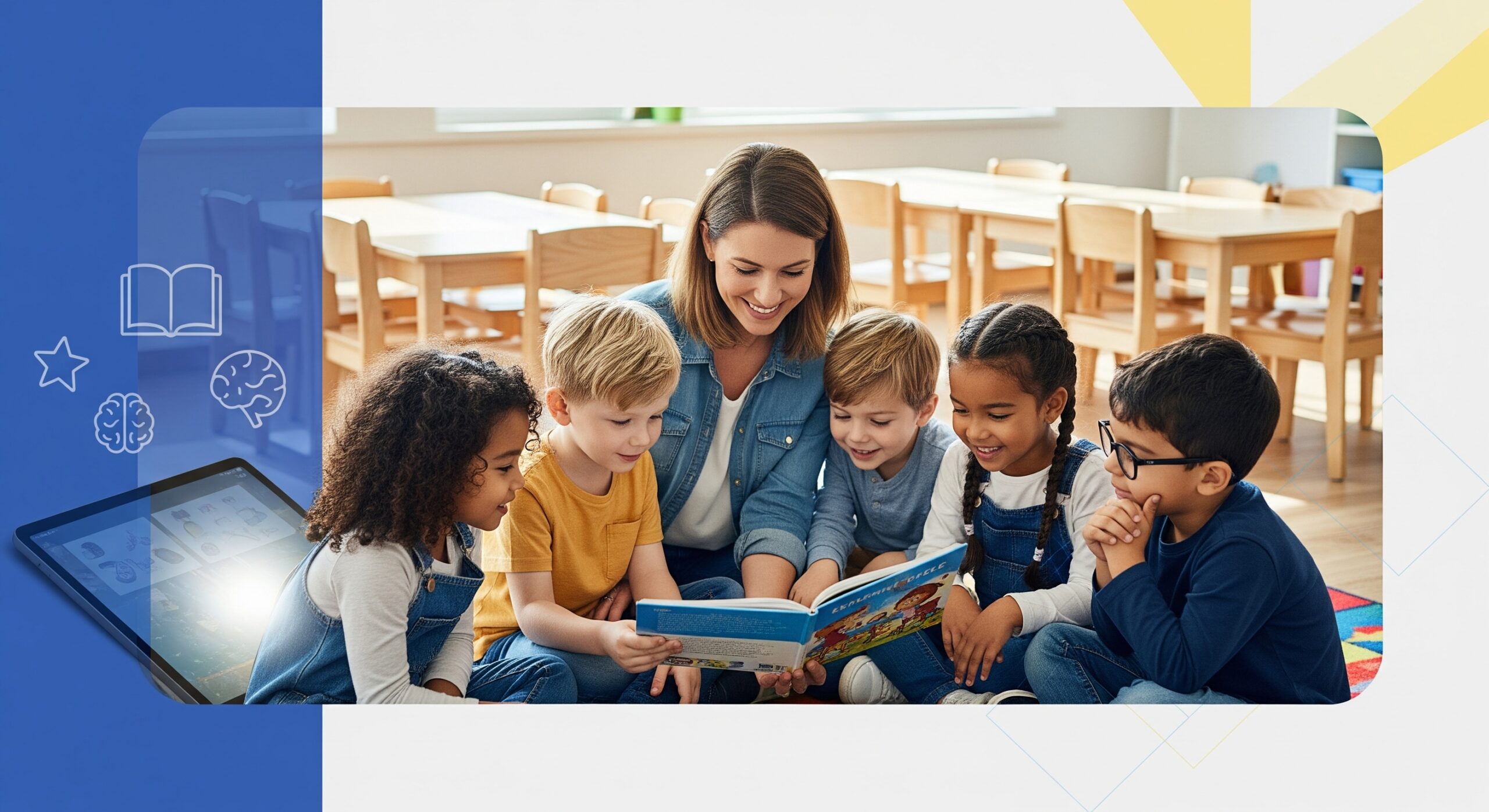
Reading is not just another academic subject, it’s the foundation for success across all areas of learning. Children who develop strong reading skills in the early years are more likely to excel in subjects like science, math, and social studies. They’re also more confident learners, more engaged in school, and better prepared for long-term academic achievement.
Research shows that students who do not achieve reading proficiency by the end of third grade are four times more likely to drop out of high school. Early reading skills are predictive of high school graduation rates, future income levels, and even civic engagement. This makes early literacy not just an educational priority, but a social and economic imperative.
Reading is also deeply personal. It influences how children see themselves as learners. Success in reading builds self-esteem, motivation, and curiosity, while persistent struggles often lead to frustration, disengagement, and avoidance of schoolwork.

Despite Best Intentions, Many Children Still Struggle
Even with increased awareness and resources, many children continue to fall behind in reading. National assessments consistently show that over 60% of U.S. fourth graders are not proficient readers, and the numbers are even more alarming for English Language Learners and students with learning differences.
Several factors contribute to this struggle:
- One-size-fits-all instruction in overcrowded classrooms
- Inadequate exposure to explicit phonics and fluency practice
- Lack of access to personalized or at-home reading support
- Unaddressed learning differences such as dyslexia, ADHD, or speech delays
Educators and parents alike are doing their best, but without the right tools, even the most dedicated efforts can fall short. What’s needed is an approach that combines research-backed instruction with accessible, real-time support tailored to each child’s unique reading journey.
That’s where the science of reading, and platforms like Readability, come in.

Understanding Reading Growth
Reading growth refers to a child’s measurable improvement across key areas of literacy development over time. It is not just about reading more books, it’s about reading better.
Core components of reading growth include:
- Fluency: The ability to read with appropriate speed, accuracy, and expression. Fluent readers can decode words quickly and focus more on meaning.
- Vocabulary: Understanding the meaning of words and phrases encountered in texts, which supports both comprehension and expressive language.
- Comprehension: The ability to make sense of what is read, identifying main ideas, making inferences, and drawing conclusions.
- Reading Level Advancement: Demonstrated progression from one reading level to the next, often measured by tools like Lexile scores, guided reading levels, or custom benchmarks within platforms like Readability.
When students experience reading growth, they not only develop stronger literacy skills, they also build confidence, independence, and a love of reading that fuels long-term academic success.
Why Early Reading Proficiency Matters
Reading by third grade is a critical milestone in a child’s academic journey. Up to third grade, children are learning to read. From fourth grade onward, they are expected to read to learn. If students fall behind during this transition, catching up becomes exponentially harder.
According to the National Center for Education Statistics, students who are not proficient in reading by the end of third grade are:
- 4x more likely to drop out of high school,
- More likely to struggle with core academic subjects,
- At greater risk for behavioral issues and school disengagement.
Third-grade reading proficiency is considered a “make-or-break” benchmark, one that significantly impacts long-term educational and life outcomes.
This is why early reading growth isn’t just about short-term gains, it’s about building a foundation for lifelong learning and opportunity.

Common Barriers to Reading Growth
While the importance of early reading success is widely recognized, many children still face barriers that prevent them from making consistent progress:
1. Dyslexia and Other Learning Differences
Children with dyslexia or processing challenges may struggle to decode words, leading to slower reading rates, poor comprehension, and low self-esteem. Without specialized support, their growth can stagnate despite strong effort.
2. ADHD and Attention Regulation Issues
Students with ADHD may have difficulty maintaining focus during sustained reading tasks. This can hinder fluency development and comprehension, especially in traditional instructional settings that lack interactivity or real-time feedback.
3. English Language Learner (ELL) Status
ELL students often face the dual challenge of learning English while also developing grade-level literacy skills. Limited vocabulary, unfamiliar syntax, and pronunciation challenges can all delay reading growth unless addressed through targeted, scaffolded instruction.
4. Lack of Individualized Instruction
In crowded classrooms, it’s difficult for educators to provide one-on-one support that adapts to each learner’s pace and needs. Students who need extra help may slip through the cracks without timely interventions.
5. Limited Access to Quality Resources
Children from underserved communities often lack access to books at home, literacy-rich environments, or supplemental tutoring. This lack of exposure and practice can significantly limit growth over time.
Reading growth is not guaranteed, it must be cultivated intentionally through research-based methods, consistent practice, and personalized support. That’s why tools like Readability, which adapt to each child’s unique path, play a vital role in helping students overcome these challenges and thrive.

The Science of Reading: Foundations for Growth
The Science of Reading is a body of interdisciplinary research from cognitive psychology, neuroscience, linguistics, and education that explains how the brain learns to read. It offers conclusive evidence about what works, and what doesn’t, in teaching children to become skilled readers.
One of the foundational resources in this field is the National Reading Panel Report (2000), which reviewed over 100,000 studies to identify the most effective reading instruction methods. This report, along with newer research consolidated in briefs like the Science of Reading from the National Center on Improving Literacy, has reshaped how educators, literacy specialists, and programs like Readability approach reading instruction.
The Five Pillars of Literacy
The Science of Reading identifies five essential components, or “pillars”, that must be taught explicitly and systematically to promote successful reading development:
1. Phonemic Awareness
The ability to hear, identify, and manipulate individual sounds (phonemes) in spoken words.
- This is a precursor to decoding, it’s about tuning into the sounds in language even before letters are introduced.
- Example: Recognizing that the word cat has three distinct sounds: /k/ /a/ /t/.
Why it matters: Students with strong phonemic awareness are better equipped to break apart and blend words, a critical skill for decoding unfamiliar text.
2. Phonics
Understanding the relationship between letters and their sounds.
- Phonics instruction teaches children to decode written language by sounding out words.
- This involves learning spelling patterns, digraphs, blends, and syllables.
Why it matters: Explicit phonics instruction allows readers to tackle new and increasingly complex words with confidence, which is key to moving from emergent to fluent reading.
3. Fluency
Reading with speed, accuracy, and proper expression.
- Fluency bridges word recognition and comprehension.
- A fluent reader can focus on the meaning of a text rather than getting stuck on decoding every word.
Why it matters: Without fluency, comprehension suffers. Students need practice and feedback to develop this skill, which is why Readability’s real-time feedback system is so effective.
4. Vocabulary
The body of words a child understands and can use.
- Vocabulary includes both oral and written language.
- It can be taught directly (explicit definitions) or indirectly (exposure through reading).
Why it matters: A rich vocabulary allows readers to access and understand more complex texts, engage in meaningful discussions, and make sense of what they’re reading.
5. Comprehension
The ability to understand, interpret, and connect ideas in a text.
- This includes identifying the main idea, making inferences, drawing conclusions, and summarizing information.
- Comprehension is both a goal of reading and a process that requires active thinking and background knowledge.
Why it matters: Comprehension is the ultimate purpose of reading. A student can decode fluently but still struggle academically without comprehension strategies in place.
Explicit, Systematic, and Multisensory Instruction
What sets the Science of Reading apart is its emphasis on how these five pillars are taught:
- Explicit instruction means skills are taught clearly and directly, rather than assumed to develop naturally.
- Systematic instruction means there is a planned, logical progression, especially in phonics and decoding, so students build on prior knowledge.
- Multisensory engagement(auditory, visual, and kinesthetic) reinforces learning through multiple brain pathways. For example:
- Hearing a word
- Seeing the word on screen
- Saying the word aloud
- Interacting with visual cues
How Readability Aligns
Readability incorporates the Science of Reading by embedding these core components into its AI-powered platform. Students:
- Practice phonemic awareness and phonics through read-aloud tasks.
- Receive real-time fluency feedback on pace and pronunciation.
- Build vocabulary through interactive definitions and context-based learning.
- Engage in spoken comprehension assessments after each book.
And because instruction is adaptive, interactive, and grounded in evidence-based practice, Readability ensures no pillar is overlooked, setting kids up for lasting reading growth.

Evidence of Success: What the Data Shows
One of the most powerful aspects of Readability is that it doesn’t just promise progress, it delivers measurable results. Backed by real-time data, student case studies, and independent pilot studies, the platform has demonstrated a consistent and positive impact on children’s reading growth across diverse populations.
Below are key performance indicators that highlight Readability’s proven success.
Fluency Gains: 74% of Students Showed Significant Improvement
Reading fluency is a strong predictor of reading comprehension and overall literacy success. In a comprehensive 2023 analysis of nearly 600 students using Readability:
- 74% of students showed measurable improvements in reading fluency.
- Students demonstrated increased reading accuracy, speed, and confidence, essential indicators of foundational growth.
- In some cases, fluency gains reached over 100% improvement in words correct per minute (WCPM), particularly for students starting below grade level.
This was not limited to advanced readers, students from all starting points, including those far below grade level, demonstrated strong growth when given consistent, targeted reading practice with real-time feedback.
Reading Level Advancement: 138 Books Read Per Student Annually
On average, each student in the Readability dataset read:
- 138 books in one year,
- Across 146 unique reading days,
- With 453 comprehension questions answered per student.
This volume of sustained engagement reflects not only reading practice but also comprehension skill-building. The diversity and depth of the digital library encourage exploration across genres and topics, helping children become more fluent, thoughtful, and motivated readers.
Time on Task: Over 2,300 Minutes Read Per Student Annually
The data also showed that students logged a remarkable 2,365 minutes of reading time on average throughout the year. That equates to:
- Consistent daily reading habits,
- More than 38 hours of structured, supported reading,
- Without the need for tutoring, test prep, or rigid schedules.
This amount of independent, scaffolded reading time contributes heavily to fluency, vocabulary development, and comprehension, all while reducing learning loss and reading fatigue over long breaks like summer.
Snapshots of Student Progress Across Reading Levels
Readability tracks each student’s starting level and charts progress over time. Here are just a few examples from the platform’s 2023 dataset:
- Student A (Grade 3, Far Below Grade Level): Started at Level 0 → Progressed to Level 1
Fluency gain: 288% increase in WCPM - Student B (Grade 5, At Grade Level): Started at Level 1 → Progressed to Level 5
Fluency gain: 142% increase
Reading time: 5 months in program - Student C (Grade 6, Far Below Grade Level with dyslexia): Started at Level 1 → Progressed to Level 3
Read 45 books in one month alone
These case studies showcase growth regardless of starting point, proving that Readability works for all learners when used consistently.
These results are not anomalies, they reflect what happens when science-based literacy instruction is combined with adaptive technology and consistent practice.
With Readability, students don’t just read more, they:
- Understand more
- Retain more
- And most importantly, believe in themselves as capable readers
Reading is the key that unlocks every child’s learning potential, help them thrive from their earliest school years onward. With Readability Tutor, you don’t have to hope for progress or feel uncertain about which steps to take next. Our award-winning app empowers students in grades K-6 to improve fluency, comprehension, and vocabulary, all through interactive, one-on-one support that adapts to each journey. See measurable growth and lasting confidence with evidence-based instruction grounded in the science of reading. Start your child’s reading transformation with Readability Tutor today, where every learner can achieve, excel, and discover a lifelong love for reading.

 Español
Español